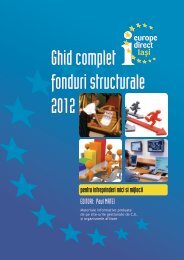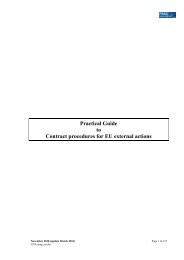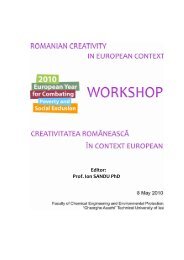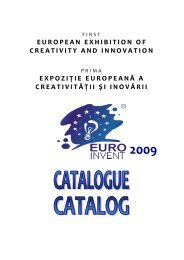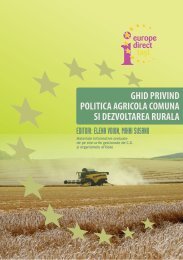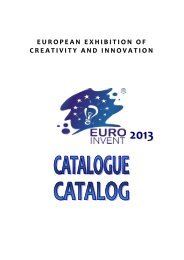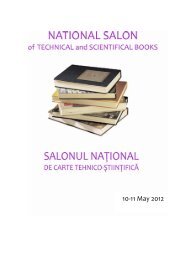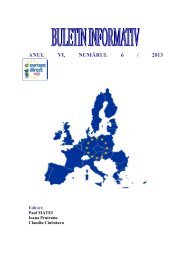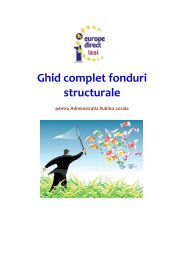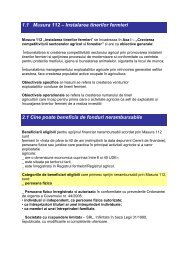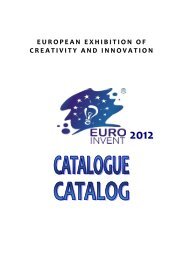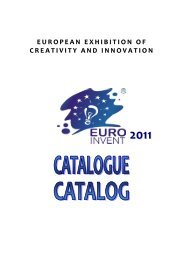Download - Europe Direct Iasi
Download - Europe Direct Iasi
Download - Europe Direct Iasi
You also want an ePaper? Increase the reach of your titles
YUMPU automatically turns print PDFs into web optimized ePapers that Google loves.
CLASS 1 EUROINVENT 2010 CLASA 1<br />
Description<br />
EN<br />
Descriere<br />
RO<br />
In the textile finishing and dyeing industries, the total volume of<br />
water consumed is around 150 millions tons/year, meaning that<br />
very large quantities of water are processed and produced as<br />
wastewater by textile plants worldwide. Quality indicators of textile<br />
wastewaters, like BOD and COD, have values which, in some<br />
cases, exceed 5 times the maximum concentration value (allowed<br />
by the national quality standards). One of the greatest concerns in<br />
wastewater treatment of a textile effluent is the colour, not only as<br />
an aesthetic problem, but also as a pollution problem. Dyes and<br />
pigments from the printing and dyeing operations are the principal<br />
sources of colour in this type of effluents with concentrations in the<br />
final effluent around 10 mg/L. Recovery, recycling and reuse must<br />
be effective tools in minimizing pollutant releases in the<br />
environment. Usually, ultrafiltration is used as a single step in<br />
advanced wastewater treatment, either for internal or external<br />
recycling. The aim of this study is to obtain higher removal<br />
efficiencies of contaminants using an innovative 2 step advanced<br />
treatment: ultrasonication, followed by ultrafiltration. During the<br />
treatment ultrasonication destroys most of the dye molecules and<br />
ultrafiltration retains the remaining dye molecules and suspended<br />
solids and colloids formed in the previous process. The integrated<br />
process of ultrasonication-ultrafiltration is proved to be very<br />
efficient not only in the removal of dyes but also for phenolic<br />
compounds. The removal efficiencies obtained are over 80% for<br />
organic compounds such as dye molecules and over 98% for<br />
suspended solids and colloids.<br />
In industria textila, volumul total de apa consumata este de<br />
aproximativ 150 milioane t/an, ceea ce inseamna ca o cantitate<br />
foarte mare de apa este utilizata in procese si este apoi evacuata ca<br />
apa uzata din unitatile industriale textile din intreaga lume.<br />
Indicatorii de calitate ai apelor uzate din industria textila, cum ar fi<br />
consumul biochimic de oxigen CBO 5 si consumul chimic de oxigen<br />
CCO-Cr, au valori care, in unele cazuri, depasesc de 5 ori<br />
concentratiile maxim admisibile (indicate de standardele nationale<br />
de calitate).<br />
Una dintre principalele probleme in ceea ce ce priveste epurarea<br />
efluentilor din industria textila este culoarea, nu doar din motive<br />
estetice, ci mai ales din motive de poluare. Colorantii si pigmentii<br />
proveniti din operatiile de vopsire sunt principalele surse de culoare<br />
in acest tip de ape uzate, avand concentratii in jurul valorii de 10<br />
mg/L in efluentul final.Recuperarea, recircularea si reutilizarea<br />
apelor epurate trebuie sa constituie instrumente eficiente in<br />
minimizarea emisiilor de poluanti in mediu. In general, ultrafiltrarea<br />
este utilizata ca unica treapta de epurare avansata a apelor uzate, fie<br />
pentru recircularea interna sau externa. Scopul acestui studiu este de<br />
a obtine grade de epurare ridicate a poluantilor, folosind un<br />
procedeu inovativ in 2 trepte de epurare: ultrasonarea, urmata de<br />
ultrafiltrare. In timpul procesului, ultrasonarea descompune<br />
majoritatea moleculelor de colorant, iar ultrafiltrarea retine<br />
moleculele de colorant ramase si solidele in suspensie si coloizii<br />
formate ulterior. Procesul integrat de ultrasonare-ultrafiltrare este<br />
foarte eficient nu numai pentru eliminarea colorantilor, dar si pentru<br />
30



